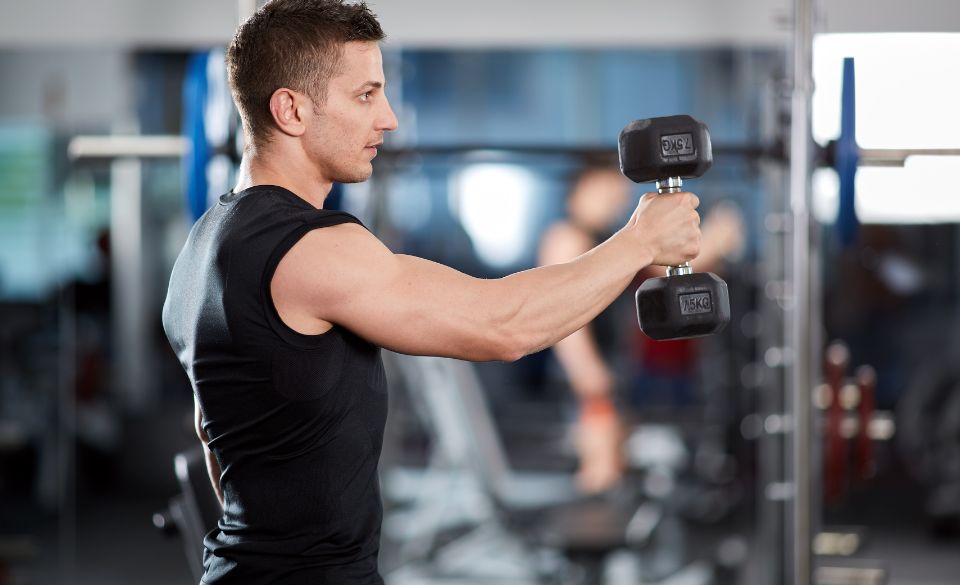
How to Train Your Rear Delts The Right Way
Page Contents
Training your rear delts is one of the most important parts of getting a well-rounded physique. Not only do they help create a balanced and aesthetically pleasing silhouette, but they also improve your posture, and can help prevent injuries in the shoulder and back. To ensure that your rear delts get the boost they need, here are some tips on how to train them the right way.
Use Isolation Exercises
When it comes to training your rear delts, isolation exercises are a must. These are exercises that specifically target the rear delts, such as bent over dumbbell laterals, reverse pec deck flys, and reverse fly machine flies. These exercises will isolate the rear delts and help build up strength and size.
What Are Isolation Exercises? – Isolation exercises are a type of strength training exercises that are used to target a specific muscle or muscle group. They can be a beneficial part of an effective strength training program, as they place emphasis on the targeted muscle to help strengthen it.
Isolation exercises are used to target muscle groups to better isolate the specific muscle that is being worked. This type of exercise is effective for building strength in certain areas of the body. This type of exercise can be used to target individual muscles like the bicep or shoulder, or entire muscle groups like the triceps, chest or back.
Isolation exercises are most commonly used in bodybuilding programs, as the focus is mainly on muscle definition and size. Isolating each muscle group enables the bodybuilder to work on building a particular muscle group while avoiding working on other muscles in the body, like the triceps or chest. While isolation exercises are effective for building size and definition, they are not always the best choice for overall strength.
When used with other exercises as part of a comprehensive training program, isolation exercises can be beneficial for overall strength. Combining isolation exercises with compound exercises, like squats, deadlifts and presses, provides a balanced workout for developing strength through more muscles than just the ones being isolated.
Choose Compound Movements
Compound movements are exercises that work multiple muscle groups at once, such as the barbell row, bent-over barbell row, and t-bar row. These exercises not only work the rear delts, but they also work the back and arms. This makes them a great way to build overall strength and size.
What Are Compound Movements? – Compound movements are exercises that involve multiple joints at the same time. This type of exercise increases muscle strength, endurance, and size, as well as reducing the risk of injury. Compound movements are also known as multi-joint exercises, because they involve more than one joint to work the muscles in unison.
Compound exercises are much different than simple isolation exercises, which target a single muscle group at a time. Compound movements challenge the body in a way that is not possible with the isolation exercises. Many times, compound exercises will require multiple sets of muscles to be trained in order to properly complete the movement.
Compound movements are most often used in resistance training, but they can also be used during aerobic workouts as well. During strength training, compound exercises can help build both muscle size and strength. Additionally, they help improve coordination and agility, as well as stabilizing stabilizing core muscles.
Compound exercises are seen as the foundation of any strength training routine. Some examples of common compound movements would be squats, deadlifts, bench press, shoulder press, lunges, overhead press and rows. These exercises are beneficial for both beginners and advanced athletes.
Mix Up Your Rep Ranges
When it comes to training your rear delts, different rep ranges can be used to target different goals. For strength, focus on lower rep ranges (3-5 reps per set) with heavier weight. For muscle mass, aim for the higher rep range of 8-12 reps per set using moderate weights.
Keep Repetitions Controlled
When it comes to training your rear delts, form is extremely important. Make sure to keep your repetitions controlled, as this will help ensure that you’re targeting the right muscle group and avoiding any unnecessary strain on your joints.
Emphasise Lower Reps
Lower reps (3-5) are great for focusing on strength and not only can they help you lift more, but can also help you to achieve a fuller looking rear delt.Explosive Movements for Growth
Explosive movements, such as dumbbell snatches, power shrugs, and jump shrugs, are great for targeting the rear delts. They’re also highly effective at stimulating muscle growth.
Use Eccentric Training
Eccentric training is a type of resistance training where the muscle is under tension throughout the entire movement. This is great for increasing muscle size and strength, as it induces microtrauma in the muscle fibers, leading to increased growth.
What Is Eccentric Training? – Eccentric training is a form of strength training that involves lifting and lowering a weight without momentum. It consists of different kinds of exercises that are designed to put more stress on the muscles than traditional weight-training exercises. The exercises focus on the eccentric contraction, which occurs when the muscle lengthens while under tension.
Unlike the concentric phase of an exercise, where the muscle shortens while under tension (the upward motion of a bicep curl, for example), the eccentric phase occurs when a muscle lengthens, like when you’re lowering the same weight back down. Eccentric training utilizes the eccentric part of of the contraction for increased muscle development. This type of training is effective for strengthening and building muscle mass, as well as improving one’s joint stability and flexibility.
Eccentric training has been known to increase strength, especially in the muscles that are involved in the eccentric contraction. Research has demonstrated that participants in eccentric training protocols have shown significantly greater strength gains than those in traditional weight-training exercises. For example, one study found that participants in a program that focused on eccentric training showed significantly greater strength gains than participants in a program that used traditional weight-training exercises.
Because of the increased force production and greater impact on muscles, eccentric movements can provide a time-efficient and effective workout. They are often used as the main component of a resistance training plan to help improve strength, power and muscle mass.
Best Exercises For Rear Delts
The rear delts, or posterior delts, are the muscles located on the back of the shoulder. These muscles are important for overall shoulder stability and strength, as well as shoulder joint health. Strengthening these muscles can help you lift heavier weights, improve posture, and even reduce your risk for shoulder injuries.
Below, we’ve listed five of the best exercises for targeting and strengthening your posterior delts.
1. Bent Over Rear Delt Flyes
Bent over rear delt flyes are one of the best exercises for targeting the rear delts, primarily because the range of motion helps to thoroughly engage the muscles. To perform this exercise, you’ll need a set of dumbbells, or one dumbbell if that’s all you have.
Start by bending your torso forward and hinging at the hips. Make sure your back is flat and that you’re keeping your chest up as you lower your torso. Keep a slight bend in your elbows and keep them held out at a 45-degree angle. As you inhale, lift your arms and open up your chest. Pause at the top of the movement and squeeze your rear delts before slowly lowering to the starting position.
2. Reverse Flyes
Reverse flyes are a great exercise for activating the rear delts, and they’re often done with a cable machine. You can also perform this exercise with dumbbells, however.
To get started, start standing upright with your feet shoulder-width apart and hold a dumbbell in each hand. Hinge forward at the hips and keep your back flat and chest up. Allow your arms to hang in front of your body as your palms face each other. As you exhale, lift your arms out to the side and squeeze your rear delts at the top for a second. Slowly lower your arms back to the starting position.
3. Upright Rows
Upright rows are another great exercise for working the rear delts, as well as the traps and biceps. You can use a barbell, dumbbells, or a cable machine.
Begin by standing with your feet shoulder-width apart, holding the weight of your choice in front of your thighs. Make sure to keep your back straight and core engaged throughout the entire motion. As you inhale, draw the weight up towards your chin, keeping your elbows flared and keeping the weight close to your chin. Pause for a second at the top of the movement, then slowly return to the starting position.
4. Face Pulls
Face pulls are a great exercise for targeting the rear delts because this movement provides good shoulder mobility and stability which is essential for shoulder joint health. You’ll need a cable machine or resistance band for this exercise.
Begin by standing up straight with your feet shoulder-width apart, and attach the cable or band to its highest point. Grab the handle or grip, and hold it right in front of your face. Make sure to keep your chest up, back straight, and core engaged. As you exhale, pull the cable or band towards your face by bringing your elbows up and out to the sides. Hold at the top of the movement and squeeze your rear delts before slowly returning to the starting position.
5. Prone DB Reverse Flyes
This exercise can be performed with a bench or a stability ball. To get started, lie facedown on the bench or ball with your feet planted firmly on the ground and hold one dumbbell in each hand. With your palms facing each other, raise the dumbbells forward and up until your elbows are raised in line with your shoulders. As you exhale, lower the weights with a slight bend in your elbows until you feel a mild stretch in your rear delts. Pause here for a second and squeeze your rear delts before repeating the movement.
These five exercises are great for strengthening and building your posterior delts. Try adding some of these moves to your next workout to help build up your back muscles and increase your overall shoulder health and strength.
Conclusion
Getting your rear delts to stand out takes a lot of hard work, but with the right exercises and training plan, you can maximize your results. By using isolation exercises, compound movements, different rep ranges, and taking adequate rest,you can create a balanced and aesthetically pleasing physique that will turn heads.
Other things to consider are:
Include Higher Rep Training
While lower reps are great for building strength, higher rep training (12-20) is great for building size and muscle density. This type of training helps create a pump effect, which promotes growth, as well as increasing the amount of blood and nutrients flowing to the area.
Take Adequate Rest
Taking adequate time off is extremely important when it comes to training your rear delts. Make sure to allow your body at least 48 hours of rest in between workouts, as this will help to ensure proper recovery and muscle growth.


